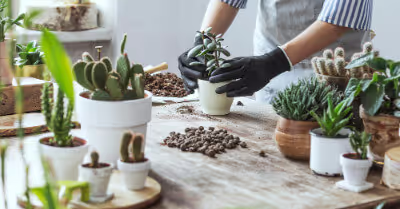Table of Contents
Why do succulents need special soil?
Succulents have unique soil needs because of their drought tolerance and shallow root structures. Because most succulents have superficial root structures, they are less tolerant to over-watering. Their roots are extremely sensitive and will not do well if they sit in water for more than a few days. They are also drought-tolerant plants which means they store water in their stems, leaves, or other foliage. In addition to the shallow root structure, succulents are able to hold their own water inside their foliage, which means that they do not need the soil to store water for them.
Because succulents do not thrive when there is excess water, you need to take additional steps to ensure the soil that your succulent is planted in is providing excellent drainage and air circulation to eliminate standing water. Due to the weak root structure of most succulents, it is also helpful to create your own mixes to better support the roots from damage.
How do I mix my own soil for my succulent?
Buying store-bought potting mix is not the best option for succulents. Potting mixes are usually just regular soil with a few dots of perlite here and there. Soil also is exceptionally heavy and carries a lot of water. If you pour water onto just soil, the dirt will absorb most of the water there instead of just letting it drain out the bottom of your pot.
Instead of just relying on store-bought soil, you soil mix your own. While some people may feel intimidated about blending their own soil, it is exceptionally easy and does not cost significantly more than regular soil.
To mix your soil, you need first to decide what materials you need. You will always need plain old dirt to start, so pick out your favorite kind of a raised bed or potting dirt. This dirt is specially formulated to provide your plant with the nutrients it would typically be pulling directly from the ground.
In addition to the soil, using add-ins such as bark, perlite, moss, and gravel are great ways to enhance your mix. Perlite is the white, rock-like, material that is commonly seen in commercial blends. This material creates air pockets in the soil which helps in drainage. It is relatively cheap to pick up, and adding more of it into your mix will help your succulent tremendously.
Bark is an excellent option to add to the top of your soil to create a protective barrier between water flowing onto the plant and the topsoil. When you water succulents, you accidentally erode the soil away from the plant due to the plant's inadequate root systems. If you add bark on top, it will help protect the topsoil from water erosion.
Moss is a helpful addition to your mix because it dries quickly, provides aeration to your soil, and is light. Very small pieces of gravel can also be added to your soil and will have a similar effect as perlite. Once you have gathered all your materials, you want to start with a seventy-five percent soil ratio to your add-ins. Once you mix that, if you believe your soil could still use more texture, add more perlite, rocks, or moss.
Your soil mix should still be mostly dirt but should have more texture like dirt in the ground would. Mixing your own soil will give your succulent a much better chance of avoiding root rot and other water-related issues that can kill the plant.
Should I put rocks at the bottom of my succulent container?
Now that you have mixed your own potting mix, your succulents are already going to be happier and healthier, but there is more you can do. Adding rocks to the bottom of your potting container can aid in drainage even further. Adding a small number of stones to the bottom of your succulents container will ensure that any excess water that is left in the bottom of the soil will be able to drain out properly.
The number of rocks you add to the bottom of your container should be proportionate to the size of your container and the size of your succulent. You should not add golf ball-sized rocks to a 4-inch container. If you have a one-gallon container, consider adding 2 inches of ½ inch rocks to the bottom of the container and then adding your soil mix on top of that. If you have a small 4-6 container, add one inch of very small rocks or pebbles to the pot before adding your custom soil mix.
The addition of rocks, perlite and bark all also aid in protecting the roots systems of your succulent. Succulents have notoriously weak root systems. They are often very small in relation to the size of the plant. Small root systems mean that any damage to them could mean that your succulent is at risk of dying. Moss or bark on the top of the soil helps to protect from soil erosion but the perlit and rocks within your pot also help your root systems. The added textures help your succulent’s roots by providing them something to ground themselves on.
Regular soil is very soft and does not provide very much support for your succulent. Adding in rocks and perlite gives the roots something to grab onto and grow around. This will mean that your succulent will be more firmly rooted in the soil. If any of your taller succulents lean to one direction or feel loose in the soil, adding rocks and perlit to your mix could fix that issue. This is particularly important for succulents that live in pots outdoors as they are more susceptible to root damage from being blown around in the wind.
Does my pot need drainage holes?
The final key in proper drainage is to make sure you have a drainage hole at the bottom of your container. If you put all this work into mixing your own potting mix and adding rocks to your container but do not have anywhere for the water to drain out, you have missed the point. A succulent should never be in a pot or container that does not have at least one hole at the bottom. If you combine properly mixed soil, a rock base, and a drainage hole, your succulent will be able to only take the amount of water it needs while the rest drains out of the pot.
A pot with no drainage holes is a sure-fire way to get root rot in your favorite succulent. If your container currently does not have holes, your first step before mixing your soil or adding rocks to your pot should be to find a way to create holes in your container. You may have to drill holes, but I promise you, it will be worth it for your succulents.
Properly mixed soil, rocks, and drainage holes are the three most important aspects of planting your new succulent. If you do these three things correctly, you will be more wiggle room in how much you water your succulent. If you over water, instead of your succulent just sitting in wet soil, the water will be able to drain out and move through your soil. Properly mixed soil will also add aeration to your soil, which means more air will be able to make its way through the soil and to your plant's roots, which is critical for succulent health and growth. Because succulents have such shallow root structures, the addition of bark or moss to the top of your soil will help keep the soil around the roots in place while watering. If you follow the pattern; hole in the container, rocks, mixed soil, moss, or bark, you should have great success with your succulents.
Recent Articles

















